Mini violets: varieties and home care
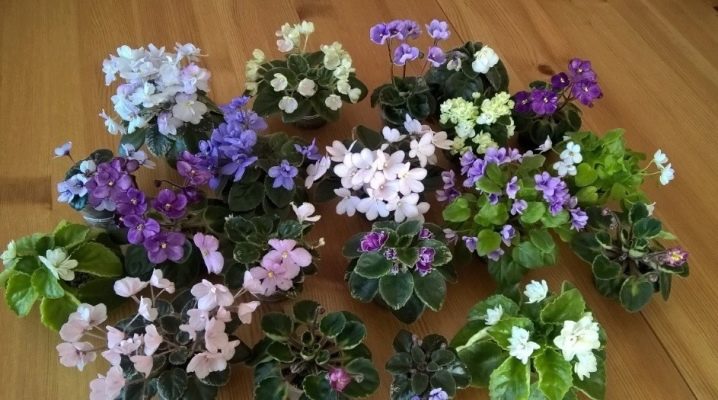
Among all compact plants grown at home, mini-violets are especially popular, the number of varieties of which is growing from year to year. These beauties make almost any room cozy, which is explained by their spectacular flowering, like a magnet attracting the attention of others. Anyone can achieve such a result: it is enough to know the rules for caring for miniature violets, adherence to which saves time and avoids most common mistakes.

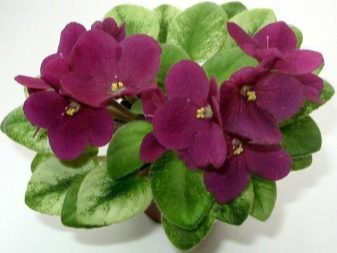
Description
Like other indoor violets (Saintpaulias), the plants in question are very aesthetic. They owe their name to the German Baron Saint-Paul, the explorer who discovered them at the end of the 19th century in the mountains of East Africa. Despite the similarity of the names, they have little in common with the “street” violet (Viola): the validity of this thesis is confirmed by the biological taxonomy that assigns these plants to different families.
Today all Saintpaulias (both regular and trailers) can be divided into 4 groups - standard and 3 miniature. The latter are classified according to the average diameter of the rosette of an adult plant, the values of which are given below:
- up to 6 cm - micro-mini (the smallest group);
- no more than 15 cm - mini;
- up to 20 cm - half-mini (the most common category).
An alternative classification option takes into account the size of the leaf plate of miniature plants, which is in the range of 0.6-1.2 cm, 1.2-2.5 cm and 2.5-3.8 cm for micro-mini, mini and semi-mini, respectively.

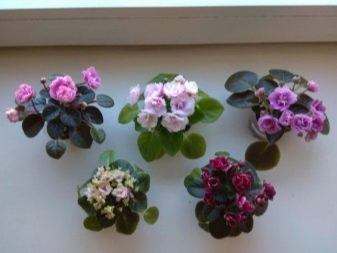
As for the botanical features of the perennial plants presented, their list is as follows:
- low height and compact root system;
- shortened stem;
- the location of the leaves in the root rosette;
- grouping flowers into inflorescences;
- the presence of a large number of villi on the surface of each sheet;
- the possibility of flowering at any time of the year;
- the formation of a fruit-box with small seeds.
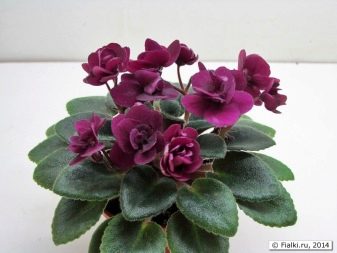
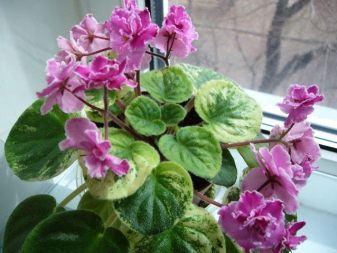
Three main advantages of mini-violets deserve special attention:
- compactness, thanks to which plants do not need a lot of space on a shelf or windowsill;
- spectacular and very abundant flowering, starting earlier than ordinary violets;
- comparative unpretentiousness and resistance to most diseases.
In addition, leafy cuttings of miniature Saintpaulias take root faster than standard-sized violets.
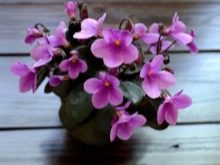
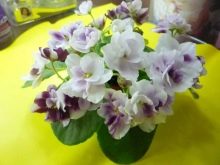
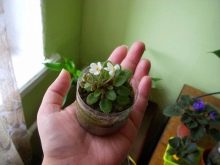
Varieties
Currently, there is an impressive number of varieties of mini-violets, markedly different in their characteristics. The colors are especially varied, which can be roughly divided into light, red, purple and blue. Consider a list of popular varieties belonging to the first category.
- Jolly Andrea. Semi-double and terry miniature "roses", attracting attention with a delicate white-lilac color. Flowering is characterized by abundance and regularity.
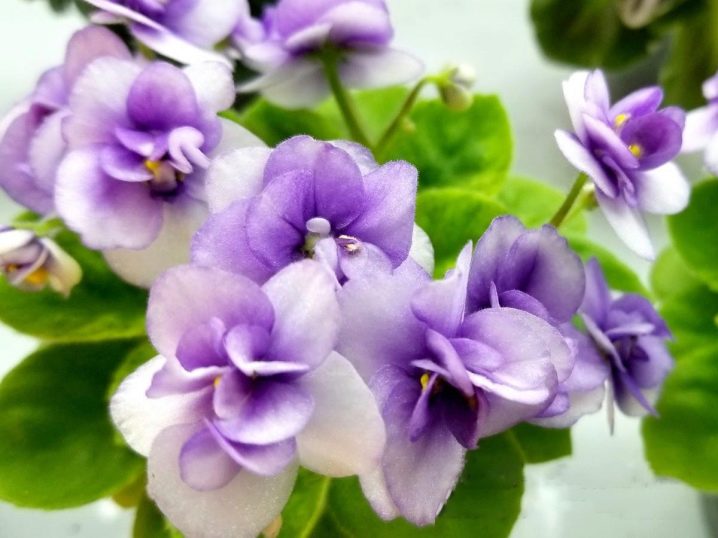
- Little Rick. Large white "stars", the petals of which are decorated with light pink spots. Other features are undemanding care and frequent flowering.
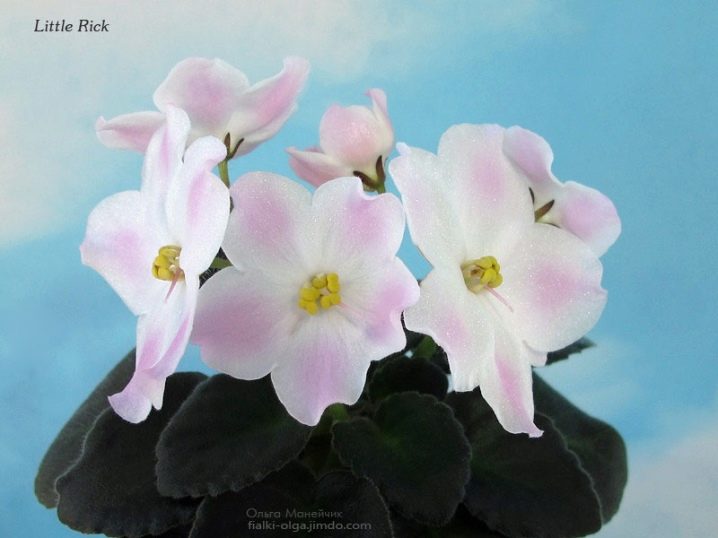
- Optimara Little Moonstone. Double white flowers with lavender-blue petals in the center. The variety attracts with long flowering (up to 12 decades), but differs in a certain moodiness.

- Jolly Mischief. Semi-double light flowers, decorated with pink markings. It blooms profusely and regularly without the formation of a cap.
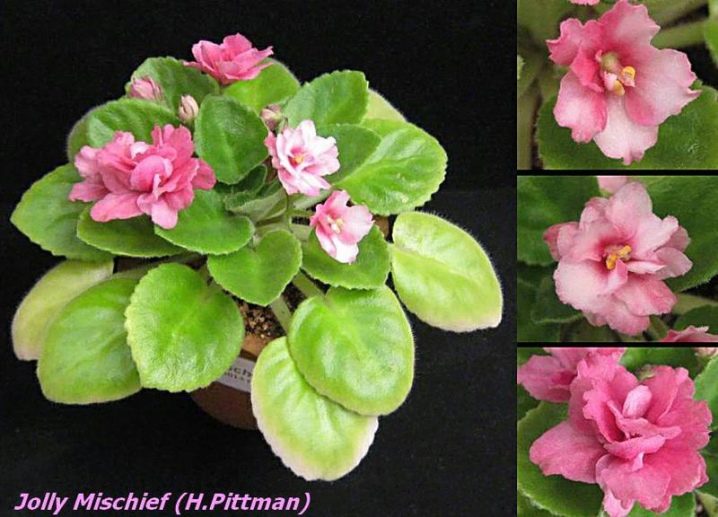
- Jolly Sun Chaser. Double white flowers with yellow spots and veins. It develops quickly, often pulls out leaves due to lack of lighting.
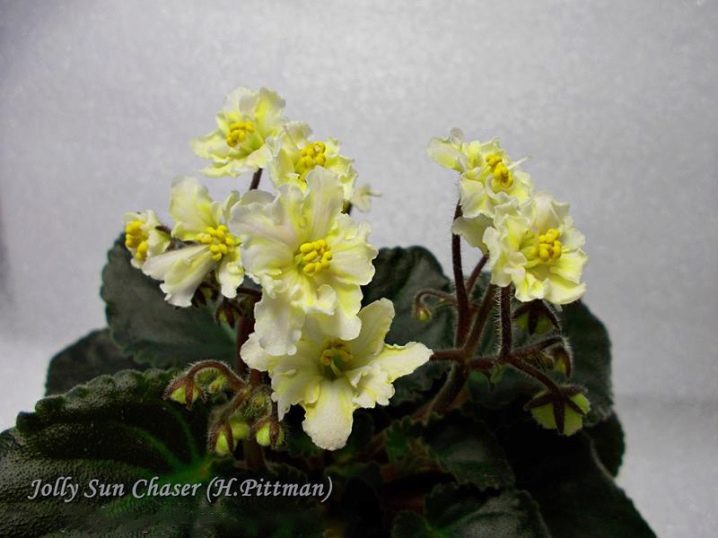
- Little White Clouds. A characteristic feature of the variety is its pure white color, which does not provide for any inclusions. Flowering is distinguished by its duration and impressive abundance.
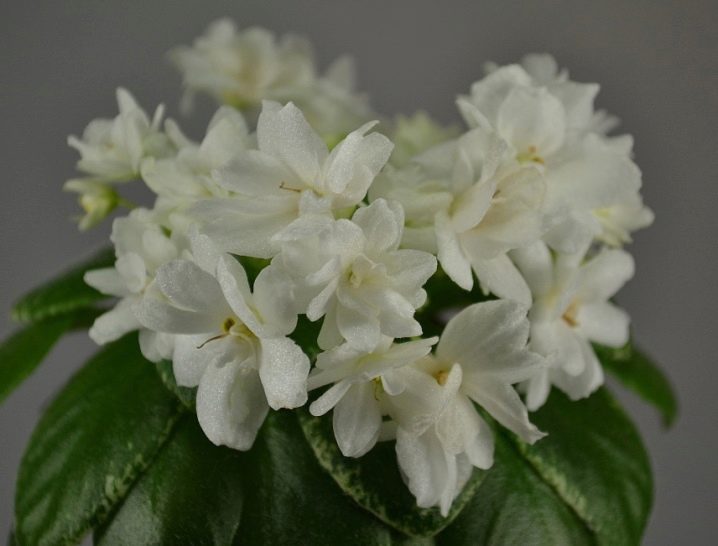
Interesting varieties of mini-violets, which are characterized by various shades of red.
- Jolly Jubilee. The flowers are characterized by a rich reddish-beet color and can be simple or semi-double. The flowering of the plant is notable for the formation of a fluffy and at the same time neat cap.
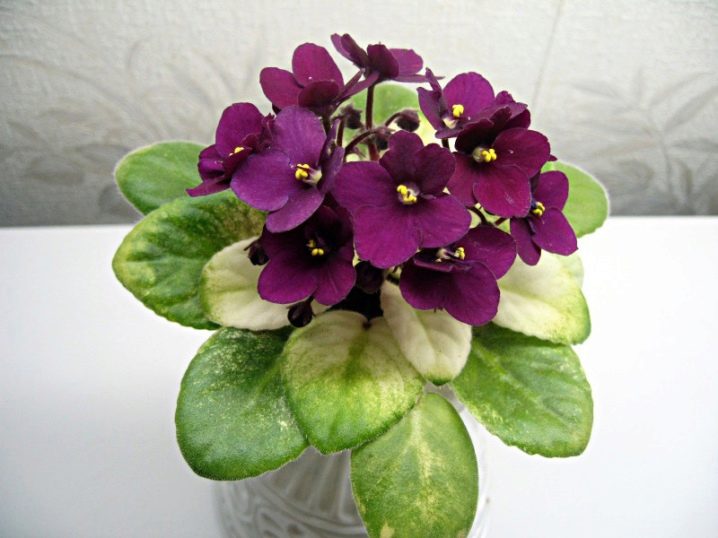
- Jolly Frills. The most notable feature is the presence of a fringed border, which gives the reddish-wine semi-double flowers additional showiness. The variety is very picky about lighting and has a slow development.
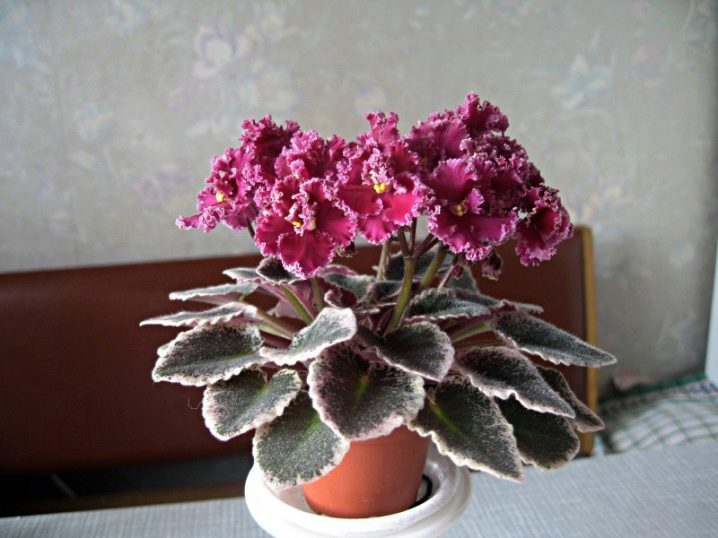
- Jolly Fireball. It is characterized by large, cap-forming double flowers with a slightly ruffled edge and a rich cherry-red hue. The socket is compact and almost perfectly symmetrical.
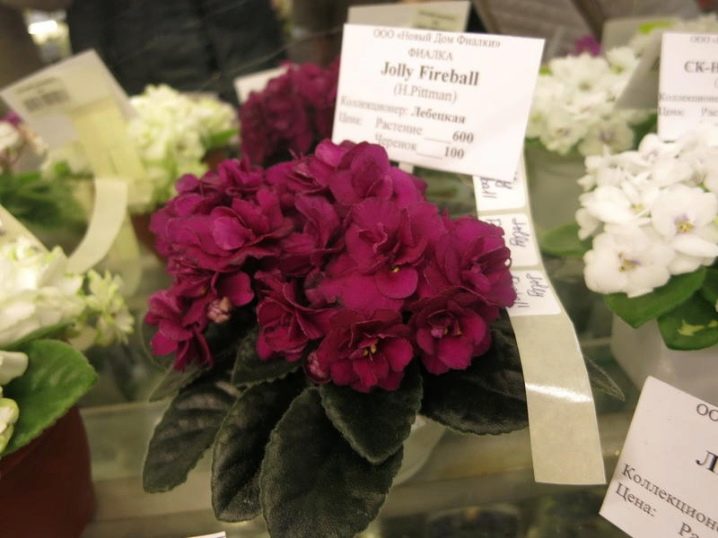
- Jolly Jan. The variety is notable for its beautiful color with a predominance of shades of vintage wine. Double or semi-double flowers form a neat cap. Such violets grow rather slowly, which is their only drawback.
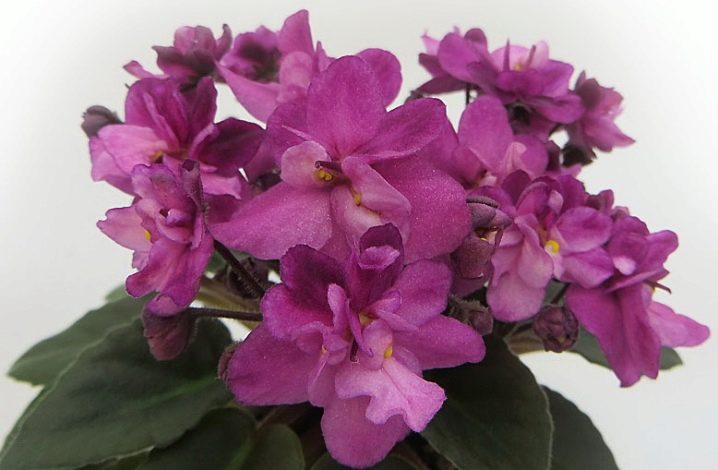
- Jolly Bambino. Another variety, which is characterized by a noble wine color. A characteristic feature is the presence of a thin white border on the petals, creating an effective contrast with the main tone. It blooms with a well-formed cap.

- Jolly Mel. It features a neat rosette and an aesthetic cap made of reddish-purple semi-double flowers. In addition, the variety is notable for its golden crown variegation.
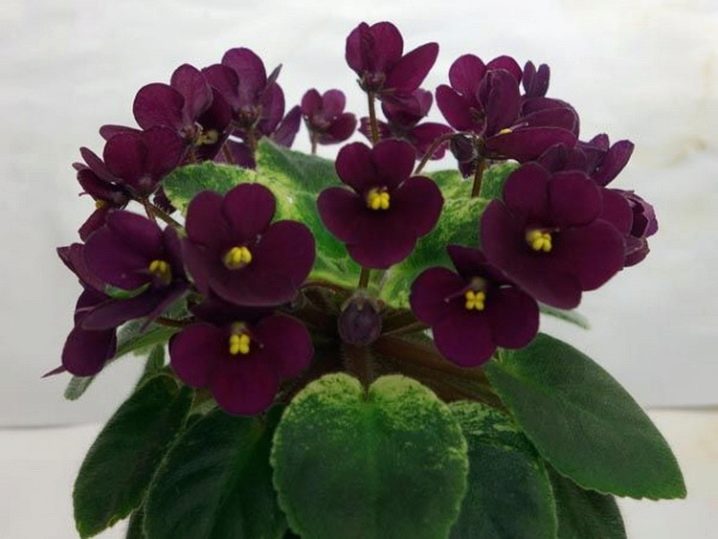
The varieties that are shaped by shades of purple include a number of plants.
- Little Caboose. The variety is characterized by relatively large lavender-lilac flowers with pronounced doubleness. Of the minuses, the unhurried development and moodiness of the plant can be noted.
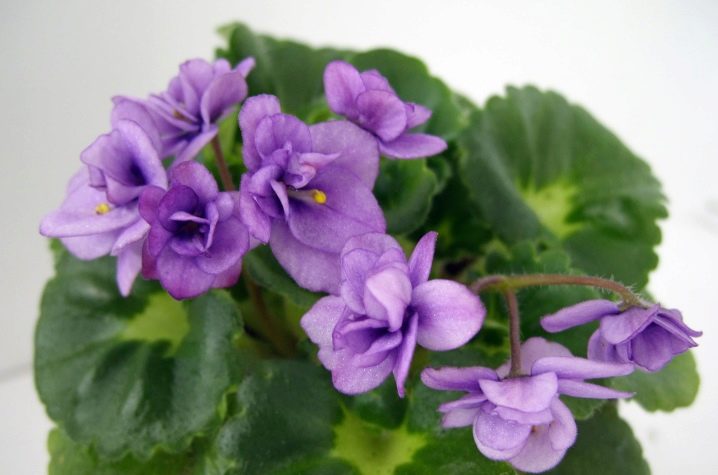
- Snuggles Lady Dawn. The variety is notable for its semi-double mauve flowers, the shape of which vaguely resembles the stars. It blooms very profusely, but cannot boast of a high growth rate.
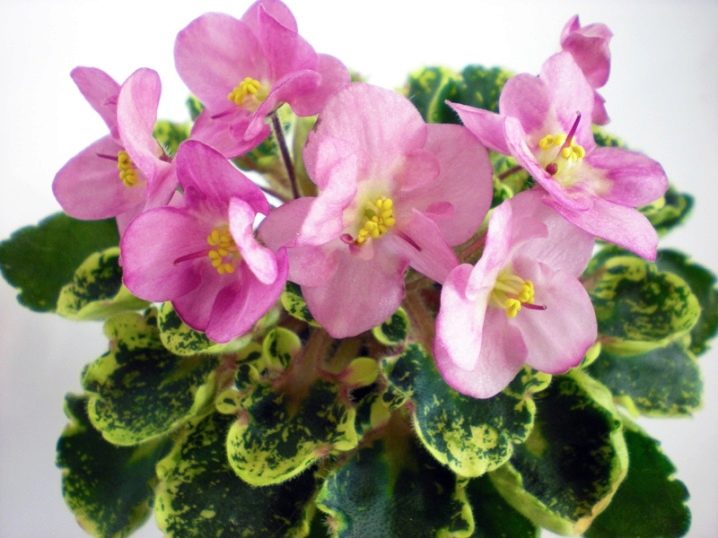
- Heavenly Girl. The main distinguishing feature is double or semi-double flowers, which attract attention with beautiful lavender-purple tints. In addition, the variety is notable for its frequent, but short-lived flowering, lasting less than one and a half decades.
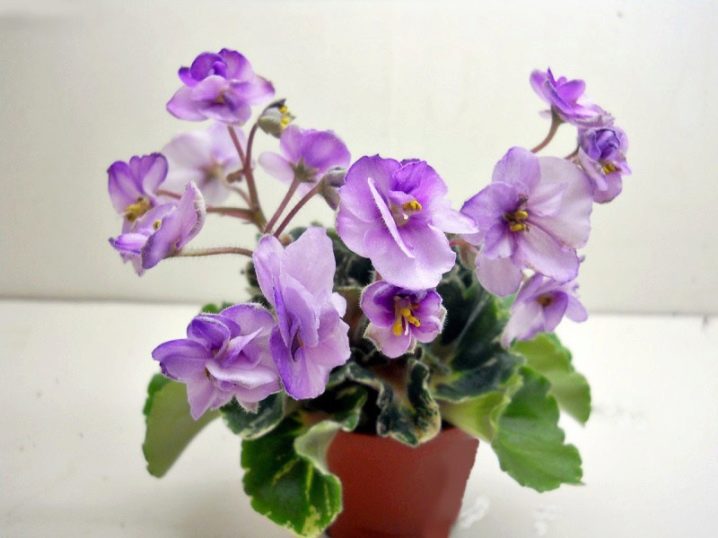
- Heinz's Little Nugget. One of the most spectacular varieties, whose semi-double flowers are adorned with 2 tones - white and blue-violet. Other advantages of the variety are unpretentiousness and rapid growth.
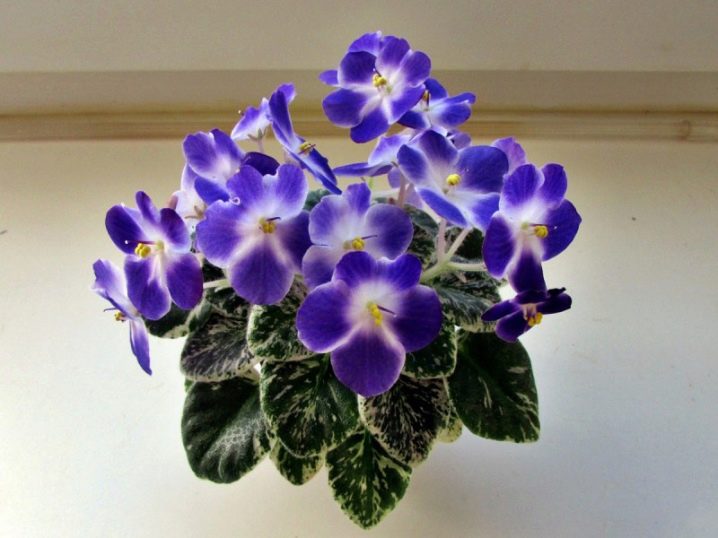
- Jolly Dazzle. Another mini-violet with semi-double flowers, the color of which suggests the presence of a blue-violet hue. The plant looks especially elegant thanks to the light edging of the petals and the lemon crown variegation.
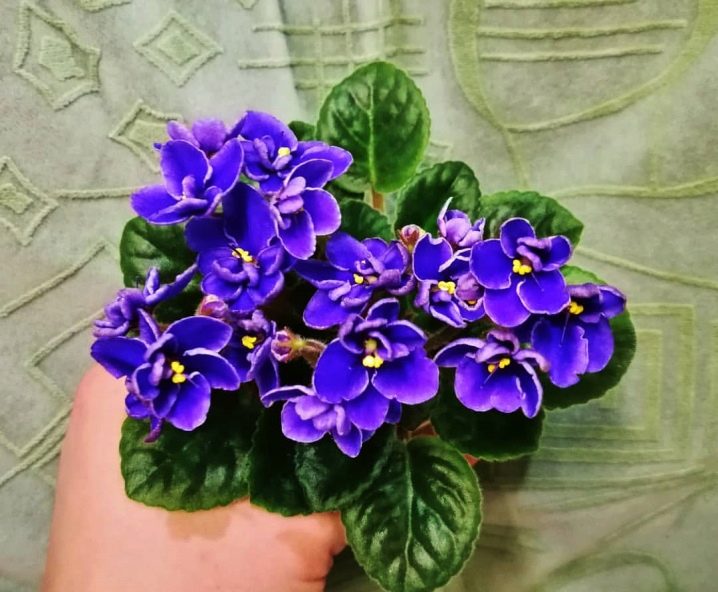
- Butterfly Blue. The peculiarity of the variety is the pronounced doubleness of the flowers, which have a rich dark purple hue. Other advantages are unpretentiousness and frequent flowering.
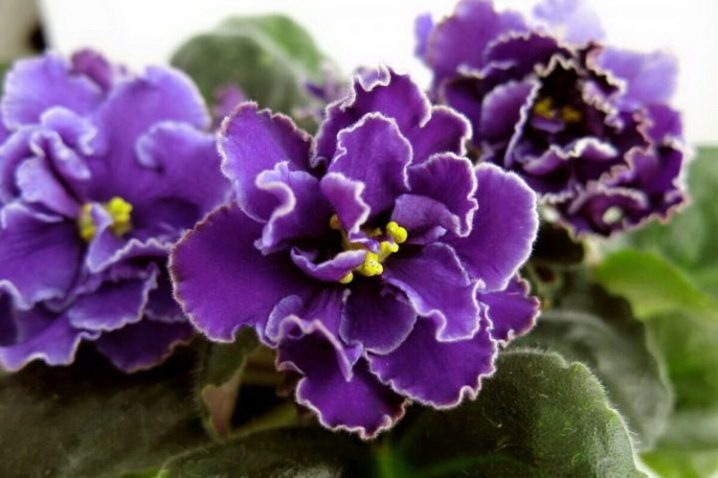
Finally, it remains to mention the Harmony's Little Stinker (Harmony) - a leafy chimera, the main decoration of which are blue semi-double flowers with white eyes. This variety is rare and expensive, and its successful cultivation involves the abandonment of artificial lighting in favor of natural.
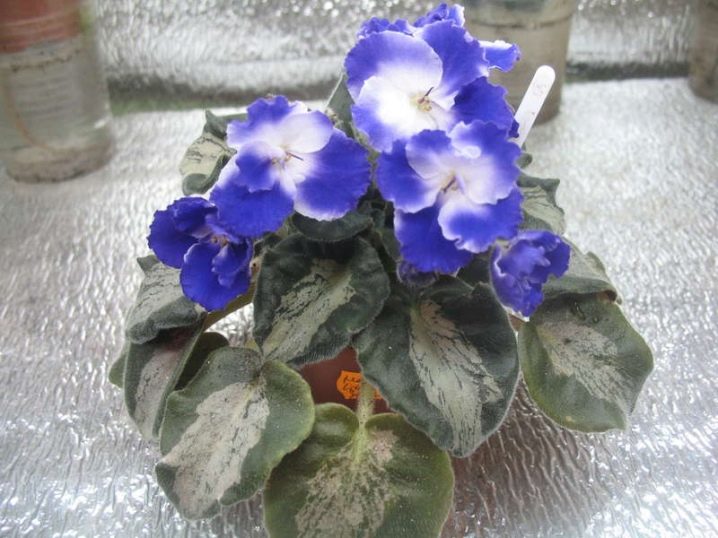
Conditions of detention
In order for the mini-violet to regularly delight with abundant flowering, it is necessary to provide a microclimate that contributes to its full development. If you single out one of the most significant conditions, the observance of which allows you to grow a beautiful and healthy plant, then that is good lighting. The solution to this problem involves taking into account the following simple rules:
- when choosing a place for a plant, you need to minimize the likelihood of direct sunlight falling on it;
- the recommended duration of daylight hours for miniature Saintpaulia is from 10 to 12 hours;
- the optimal place for a mini-violet is a window sill, oriented to the west or east;
- in order to avoid uneven development of the plant, it must be periodically unrolled.
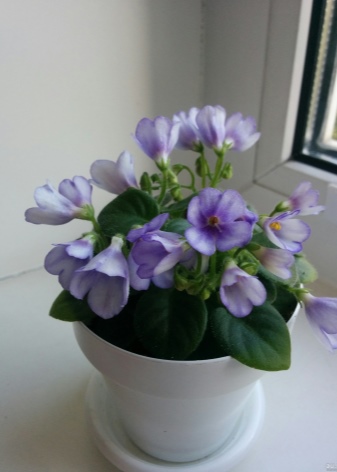
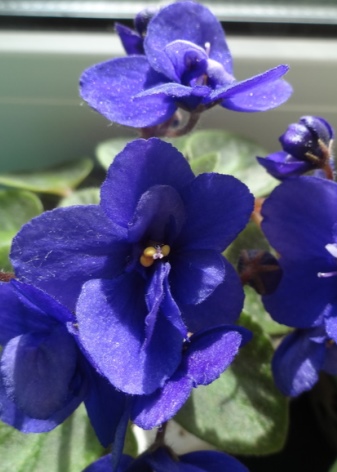
The second condition, which is vital for any mini-violet, is compliance with the optimal temperature regime, which is within + 20.25 ° С. Particular attention should be paid to protecting the plant from drafts, especially in the autumn-spring period.
If the owner of a miniature Saintpaulia wants to extend the flowering of his pet, he should choose a lower temperature from the range mentioned above.
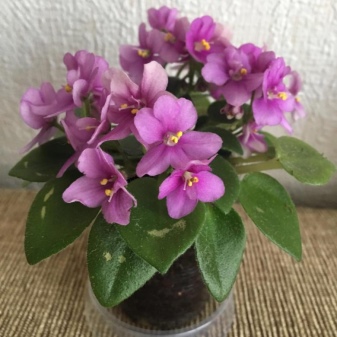

No less important is the humidity in the room: being insufficient, it leads to the drying out and deformation of the leaves of the plant, and its excess makes the mini-violet too tall and unaesthetic. To create conditions that are optimal for a miniature Saintpaulia, it is enough to adhere to three main recommendations:
- indoor humidity should not be lower than 50%;
- if the air is characterized by excessive dryness, daily spraying with a spray bottle is necessary (when performing this procedure, it is advisable not to get on the plant);
- other solutions to increase the level of humidity are the use of stationary automatic devices and the placement of a container with water near the mini-violet.
In addition, experts do not advise placing miniature Saintpaulias near batteries and other heating devices.

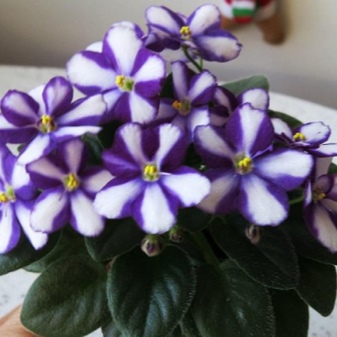
Landing
When choosing a pot for planting mini-violets, it should be borne in mind that in the process of its growth it does not need larger containers. The best option for this plant is a flowerpot, the diameter of which does not exceed 8 cm. Ignoring this condition will lead to the fact that the miniature Saintpaulia will gradually grow and lose its decorative effect.
For planting mini-violets, it is advisable to use not very fertile soil, consisting of peat, earth, vermiculite and partially rotted needles, mixed in a ratio of 6: 1: 1: 1. Another component of the composition may be charcoal added in small quantities.


Typically, miniature Saintpaulia is transplanted to replace the depleted soil with a new one. This procedure assumes several conditions:
- the optimal frequency is once a year;
- the most suitable time is the second half of winter;
- the recommended material for the container used is plastic;
- there should be drain holes at the bottom of the pot.
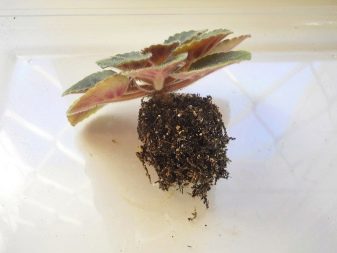
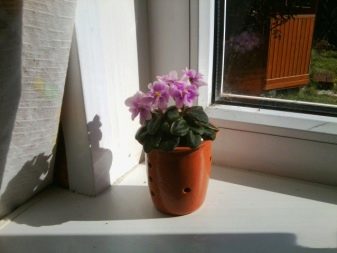
As for the transplant, it provides for the following sequence of actions:
- place a layer of sphagnum moss at the bottom of the container and cover it with a thin layer of soil;
- carefully remove the mini-violet from the old pot (along with the earthen lump);
- gently fluff the soil around the roots of the plant;
- determine the height required to immerse the bare section of the stem into the soil;
- cut the roots to a length sufficient for a comfortable location of the Saintpaulia in the new soil, and treat them with crushed charcoal;
- place a mini-violet in a pot so that the petioles of the lower leaves are on its sides;
- cover the plant with soil and tamp it thoroughly.
In conclusion, the miniature Saintpaulia remains to be put in a warm place and not watered for two days.
For information on how to properly transplant a mini-violet, see the next video.
Care
As already mentioned, any interested florist can take care of mini-violets. To solve this problem, it is enough to familiarize yourself with the recommendations regarding watering and feeding the plant, as well as effectively countering common diseases and pests.
Watering
Proper watering of the described plant involves the use of settled or filtered water - at room temperature or warm. This procedure should be carried out after the topsoil has become completely dry, adhering to a few simple conditions:
- you need to pour water not on Saintpaulia, but around it (closer to the edges of the pot);
- the result of watering should be an earthen lump, which will be completely saturated;
- in spring and summer, the procedure in question is carried out in the morning, and in autumn and winter - in the afternoon.
Watering a mini-violet, it is necessary to avoid waterlogging of the soil, which poses a threat to the root system of the plant.
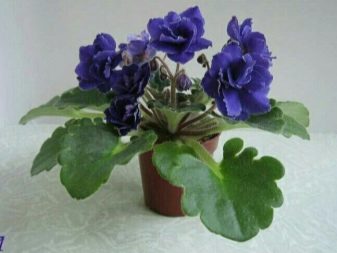
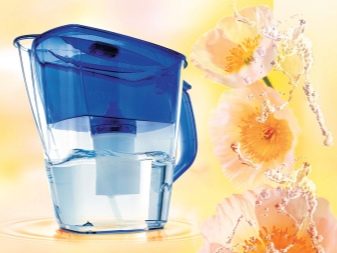
Top dressing
In order for the miniature Saintpaulia to bloom profusely, it needs a nutritious soil, but not oversaturated with fertilizers. Excessive content of the latter provokes an active growth of green mass, against the background of which the inflorescences will seem extremely small.
Experience shows that to preserve the decorative effect of a mini-violet, complex mineral dressings are sufficient, a small amount of which is applied twice a month. An alternative solution is to transplant the plant into a new soil, carried out 2 times a year (in such cases, fertilization is not required).
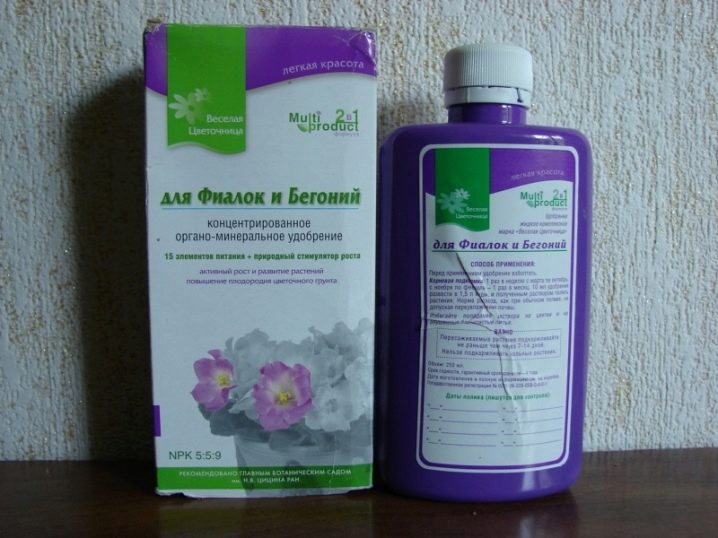
Diseases and pests
Diseases of miniature Saintpaulias can be divided into 2 groups - infectious and non-infectious. The causative agent of the former is most often the fungal microflora, while the latter develop due to improper care of the ornamental plant. To cope with the infection, it is necessary to treat the mini-violet with a broad-spectrum fungicide, strictly following the instructions for the drug used. To get rid of non-infectious diseases, Saintpaulia creates conditions that are optimal for its full development. In addition, in both cases, all affected areas are removed, followed by treatment of the plant with an antiseptic.
Of the pests, mini-violets are most often disturbed by:
- mealybug;
- aphid;
- shield;
- spider mite.
Counteraction to parasites involves two-time treatment of Saintpaulia and nearby plants with a systemic insecticide.
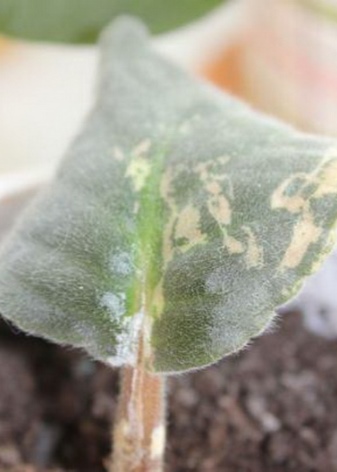
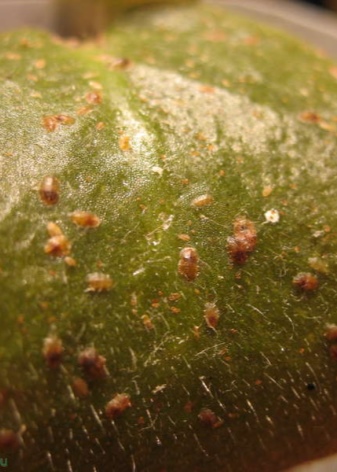
Reproduction
The most effective way to propagate a mini-violet at home is vegetative. It involves using a healthy leaf that has been carefully cut from the mother plant and treated with an antifungal agent. The further sequence of actions is as follows:
- make a cut on a leaf cutting (about 1.5 cm from the beginning of the plate);
- place the planting material in a soil consisting of peat and vermiculite (the recommended proportion is 2: 1), at a depth of about 1 cm;
- water the plant with a small amount of water and cover it with a plastic bag (the latter should have a small hole for air exchange);
- check the moisture level after 3-4 days (if the soil is not dry, you do not need to water it);
- maintain a temperature of + 22.25 ° С, which allows the plant to root with the least amount of time.
After waiting 2 weeks from the moment of planting, you can gradually accustom the cutting to the air in the room, periodically removing the plastic "cape". After 3-4 months, small strong rosettes will appear that can be separated from the mother plant.
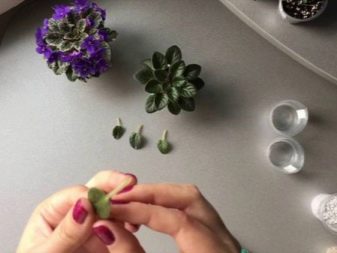

Summing up, we can state that the popularity of mini-violets is explained by a huge number of their advantages, which meet the expectations of the overwhelming majority of owners. Such plants give positive emotions to everyone who cares for them properly - both a specialist and a novice florist.
For more on caring for mini-violets, see the next video.































The comment was sent successfully.